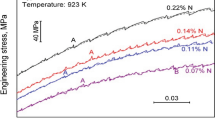Abstract
Room temperature tensile test results of solution annealed 304 stainless steel at strain rates ranging between 5 × 10−4 and 1 × 10−1 s−1 reveal that with increase in strain rate yield strength increases and tensile strength decreases, both maintaining power–law relationships with strain rate. The decrease in tensile strength with increasing strain rate is attributed to the lesser amount of deformation-induced martensite formation and greater role of thermal softening over work hardening at higher strain rates. Tensile deformation of the steel is found to occur in three stages. The deformation transition strains are found to depend on strain rate in such a manner that Stage-I deformation (planar slip) is favoured at lower strain rate. A continuously decreasing linear function of strain rate sensitivity with true strain has been observed. Reasonably good estimation for the stress exponent relating dislocation velocity and stress has been made. The linear plot of reciprocal of strain rate sensitivity with true strain suggests that after some critical amount of deformation the increased dislocation density in austenite due to the formation of some critical amount of deformation-induced martensite plays important role in carrying out the imposed strain rate.








Similar content being viewed by others
References
Gallee S, Manach PY, Thuillier S (2007) Mater Sci Eng A 466:47
Angel T (1954) J Iron Steel Inst 177:65
Talonen J, Nenonen P, Pape G, Hänninen H (2005) Metall Trans A 36:421
De AK, Speer GJ, Matlock DK, Murdock DC, Mataya MC, Comstock RJ Jr (2006) Metall Trans A 37:1875
Spencer K, Embury JD, Conlon KT, Veron M, Bréchet Y (2004) Mater Sci Eng A 387:873
Lichtenfeld JA, Mataya MC, Van Tyne CJ (2006) Metall Trans A 37:147
Powell GW, Marshall ER, Backofen WA (1958) ASM Trans Q 50:478
Okutani T, Yukawa N, Ishikawa K, Jinma T (1995) Proc Japanese Soc Tech Plast 1995 Spring, May 18–20, Tokyo, p 331
Hecker SS, Stout MG, Staudhammer KP, Smith JL (1982) Metall Trans A 13:619
Iwamoto T, Tsuta T, Tomita Y (1998) Int J Mech Sci 40:173
Bressanelli JP, Moskowitz A (1966) Trans Am Soc Met 59:223
Murr LE, Staudhammer KP, Hecker SS (1982) Metall Trans A 13:627
Lee WS, Lin CF (2001) Mater Sci Eng A 308:124
Milititsky M, Wispelaere ND, Petrov R, Ramos JE, Reguly A, Hänninen H (2008) Mater Sci Eng A 498:289
Picu RC, Vincze G, Ozturk F, Gracio JJ, Barlat F, Maniatty AM (2005) Mater Sci Eng A 390:334
Stuwe HP, Les P (1998) Acta Mater 46:6375
Chiou ST, Cheng WC, Lee WS (2005) Mater Sci Eng A 392:156
Wang Y, Zhou Y, Xia Y (2004) Mater Sci Eng A 372:186
Uenishi A, Teodosiu C (2003) Acta Mater 51:4437
Ganesh Sundar Raman S, Padmanabhan KA (1994) Mater Sci Technol 10:610
Das A, Sivaprasad S, Ghosh M, Chakraborti PC, Tarafder S (2008) Mater Sci Eng A 486:283
Das A, Sivaprasad S, Chakraborti PC, Tarafder S (2008) Mater Sci Eng A 496:98
Feaugas X (1999) Acta Mater 47:3617
Feaugas X, Haddou H (2003) Metall Trans A 34:2329
Flinn JE, Field DP, Korth GE, Lillo TM, Macheret J (2001) Acta Mater 49:2065
Narutani T, Takamura J (1991) Acta Metall Mater 39:2037
Byun TS, Hashimoto N, Farrell K (2004) Acta Mater 52:3889
Fang XF, Dahl W (1991) Mater Sci Eng A 141:189
Lee TH, Oh CS, Kim SJ (2008) Scr Mater 58:110–113
Bracke L, Kestens L, Penning J (2007) Scr Mater 57:385
Dieter GE (1988) Mechanical metallurgy, SI metric edn. McGraw-Hill, London
Narutani T (1989) Mater Trans JIM 30:33
Author information
Authors and Affiliations
Corresponding author
Rights and permissions
About this article
Cite this article
Kundu, A., Chakraborti, P.C. Effect of strain rate on quasistatic tensile flow behaviour of solution annealed 304 austenitic stainless steel at room temperature. J Mater Sci 45, 5482–5489 (2010). https://doi.org/10.1007/s10853-010-4605-2
Received:
Accepted:
Published:
Issue Date:
DOI: https://doi.org/10.1007/s10853-010-4605-2



